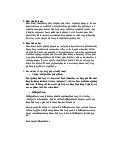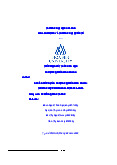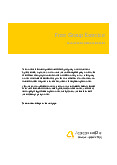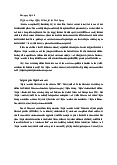









Preview text:
HO CHI MINH CITY UNIVERSITY
OF FOREIGN LANGUAGES - INFORMATION TECHNOLOGY
FACULTY OF BUSINESS ADMINISTRATION COURSE OUTLINE
(Issued in accordance with the Decision No …../QĐ-ĐNT, … /… /202….
By Ho Chi Minh City University of Foreign Languages - Information Technology) 1. Specifications
COURSE TITLE: BASIC MARKETING Course ID Credit hours 3 Instructor names Do Hoang An Nhien Emails nhiendha@huflit.edu.vn Type of course Mode of delivery Related courses Pre-requisites Total periods 45 Faculty
Faculty of Business Administration Other information 2. Overview
The course provides the most basic knowledge about marketing, the influence of marketing in
the business, marketing trends in the trend of globalization, the environment and some marketing information.
Students will be able to analyse market segmentation, identify target markets and position
goods in the market; analyze customer characteristics and behavior though examining applied
and real world examples to develop and understanding the importance of marketing for the
organisation's success; understand how the customer is the focal point of the organisation and
work outward from there into understanding the marketplace, the strategies needed
to compete in that marketplace and how we then communicate and co-create value with the consumers. 3. Objectives 3.1. Knowledge:
- Students can explain the importance of marketing in a business, and understand consumer and business behavior.
- Students can identify research process & model and variables; know how to design scales in
research; how to choose appropriate market segments, target markets, and specific market
positioning for any product or organization.
- Students can Define strategies for the marketing of products and services and plan, organize
and execute a marketing mix strategy. 3.2. Skills:
- Equipped skills to build a professional marketing plan.
- Effectively apply the management process of marketing activities: market research,
marketing mix strategy, marketing program budget, control plan...
- Ability to take advanced marketing management knowledge tests.
3.3. Autonomy and responsibility
- Be able to apply learned knowledge flexibly and creatively in each practical situation at the unit.
- Have a clear sense of self-studying and actively absorbing knowledge; proactively explore,
learn and constantly develop yourself; be responsible to successfully complete professional
activities within the scope of responsibility.
4. Course Learning Outcomes CLO Outcomes PLOs CLO1
Understand the basics of marketing; apply specialized words and PLO1
terms in specialized business activities in finance, economics,
marketing, human resources and related issues CLO2
Choose from extensive reading comprehension materials to read PLO2
on your own and improve your marketing & related reading
comprehension skills; analyze the types of questions in the
reading comprehension passage to choose the appropriate answer. CLO3
Synthesize the marketing strategies of the products and services PLO2, PLO5,
of the business which will be applied on the basis of satisfying the PLO8
expected value of customers corresponding to the relevant marketing topic assigned. CLO4 PLO2, PLO4,
Present issues related to different strategies in marketing PLO5, PLO8 CLO5
Have ability to solve a number of real-life marketing situations at PLO4, PLO5, the organization/enterprise. PLO7, PLO8 CLO6 PLO1, PLO6,
Have ability to work in teams/projects. PLO7, PLO8
5. Method of Instruction No Methods . 1
Lecture-based learning: A traditional way to structure classroom learning is the
lecture format, in which teachers explain information while students observe.
Lecturers lead a lesson by presenting on, showing visuals of and modeling examples
of a topic. While a teacher is presenting, students can listen, watch, take notes and
copy the teacher's demonstrations. 2
Technology-based learning: Lecturers can use technology in the classroom to make
teaching processes more efficient and aid in student learning. Students can use
devices like computers and tablets to read materials, conduct research or play
educational games. In addition, cloud computing capabilities make it possible for
students to access documents or other resources while at school or at home. 3
Group learning: Segmenting students into groups is a great way to teach students
skills in collaboration. While in their teams, they can discuss subjects and learn about
the perspectives of others. It is important to encourage both class participation and
listening skills so that students can gain these abilities for the future. Lecturers can
assign group presentations so students can convey information to the rest of the class,
ask and answer questions and interact with each other. 4
Student-centred learning: Students are encouraged to take an active role in the
classroom, rather than taking part in more passive activities like listening to a lecture
or writing an essay. They will have lots of discussions with their peers and teachers,
and they’ll also be encouraged to ask questions, which is linked to inquiry-based learning. 5
Experiential learning: Encouraging creativity, helps students learn from mistakes,
fosters reflective thinking, and prepares students for future experiences. It can be
effective for several subjects, especially during science experiments, sports coaching, and group projects.
6. Textbooks and teaching aids Required textbooks: 1 William D. Basic Marketing: A Perreault Jr. Marketing Strategy Planning Approach. 17th E. Jerome Ed. McCarthy Joseph P. Cannon 2 Gary Amstrong Marketing: An Pearson Introduction. 8th Ed. & Philip Kotler 3 Philip Kotler Marketing Management: Prentice Hall An Asian Perspective. 5th Ed. Other materials
1. https://www.marketingprofs.com/
articles/2019/42258/big-data-big- opportunity-
https://www.ama.org/marketing-news
https://www.interbrand.com/best-
brands/best-global-brands/2019/ interactive-data/ https://www.nielsen.com/us/en/
insights/article/2019/top-5-factors- that-impacted-online-grocery- businesses-in-2019/ https://www.ted.com 7. Assessment Methods
Description of learning outcomes assessment
Summary of learning outcomes assessment Component CLOs Duration Assessment Forms Weight Schedule s Ongoing 12 weeks - Attendance CLO1, CLO2, assessment - Short tests/ quiz CLO3, CLO4, - Groupworks/ Group CLO5, CLO6 discussions with assigned 40% topics. Midterm - Midterm Test with MCQ/ Test short answers Final Exam - Multiple choice and short 60% CLO1, CLO2, questions. CLO3, CLO4, 60 multiple choice CLO5, CLO6 questions 2 short questions (analyse case study, explain business situation, suggest plan/ strategies/ solutions Total 100% 8. Learning schedule Week/ Topics Suggested Reading Homework Meeting /Assignment 1 2. Marketing Definition 1.1 What is MKT? 1.2 MKT nature and functions 1.3 Micro MKT – Macro MKT? 2 3.
Marketing Plan & Marketing Strategy 2.1. What is MKT Plan? 2.2. The importance of MKT Strategy. 2.3. Market analysis. 2.4. MKT Opportunities 3 :
MKT opportunities in the changing market 4. 3.1. MKT Environment.
5. 3.2. MKT Competitive environment. 6. 3.2.1. PEST analysis 4
Market segmentation/ Target market/ Positioning 7. 4.1. Market analysis.
8. 4.2. Market segmentation dimensions 9. 4.3. Postitioning 10. 4.4. Target market. 5 11. 12. Consumer Behaviors 13. 6.1. Consumer behaviors?
14. 6.2. Factors influence the consumer behaviors.
15. 6.3. Consumer Market and Business Market. 6 16. Products Strategy
17. 9.1. Products – Goods & Services.
18. 9.2. Product categories (Consumer/ Business market). 19. 9.3. Branding/ Packaging
20. 9.4. PLC & Marketing mix 21. 9.4. Branding strategy 7
22. Place strategy – Distribution channels. 23. 11.1. Place strategy
24. 11.2. Direct / indirect channels. 25. 11.3. Channel conflicts. 26. 11.4. VMS 8 9 Chapter 14:
Promotion Strategy – ICM 27. 14.1. Integrated MKT communication? 28. 14.2. Promotion startegy. 29. 14.3. Promotion tools.
30. 14.4. Push & Pull MKT Strategy. 10 Chapter 15
Personal Selling and Promotion
31. 15.1. The importance of personal selling
32. 15.2. Personal selling groups/ tasks
33. 15.3. Personal selling strategy 34. 11 Chapter 16:
Advertising & Promotion 35. 16.1. Advertising? 36. 16.2. Advertising tool – Communication process. 16.3 Plan & Strategy 12 Chapter 18: Price strategy
37. 18.1. Price setting strategy?
38. 18.2. Price and MKT mix startegy 39. 18.3 Case studies Course Review 9. Academic Integrity
Academic integrity is a crucial value that underpins the quality of teaching, learning, and
research at HUFLIT. Learners are expected to adhere to guidelines that include avoiding
plagiarism, working independently on individual assignments, responsibly engaging in group
work, and reporting instances of academic dishonesty. Upholding these principles promotes a
culture of academic honesty, integrity, and fairness, contributing to an environment conducive to excellence in education.




